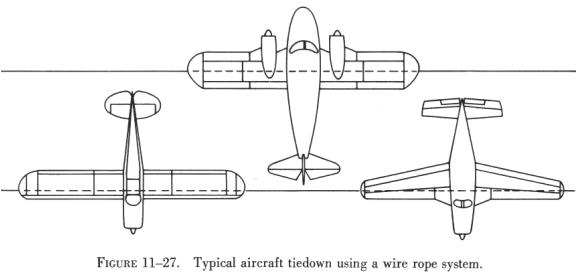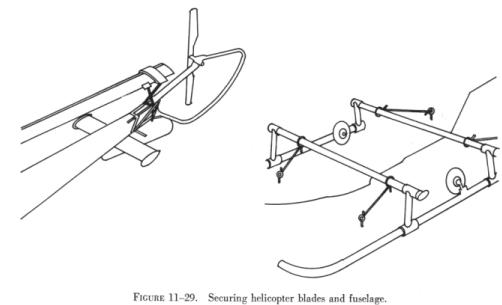
Each year many aircraft are needlessly damaged by windstorms because of negligence and improper tiedown procedures. A storm can turn a local airport into a junkyard in a matter of minutes. If an aircraft is damaged during a windstorm, the chances are it was improperly secured or was not tied down at all.
Most windstorm damage occurs during the early summer months, but can continue with lessening frequency throughout the year. As a general rule, the large and very severe windstorms cause less damage than the small local ones. This is because there is usually sufficient advance warning for the former, but the latter build up quickly and give little warning of their coming.
According to available weather records, Tampa, Florida, is the storm center of this country, with an average of 94 thunderstorms a year. Santa Fe, New Mexico, is second with a yearly average of 73. Other cities are less frequently visited by such storms. The Pacific Coast States average only one to four such storms a year. Generally speaking, thunderstorms and tornadoes are accompanied by high surface winds which account for most of the damage to aircraft on the ground.
Although most storms are generated in the daytime, many sections of the United States, including the Southwest, the lower Michigan Peninsula, and an extensive area centered in eastern Nebraska, are plagued with night storms during the summer months. Thunderstorms are bothersome in the Central States during the months of July, August, and September. On the other hand, in the winter the greatest storm activity takes place in the lower Mississippi Valley.
The map in figure 11-24 shows the yearly average number of days with thunderstorms based on observations from all U. S. Weather Bureau first order stations in the United States. A thunderstorm day is considered any day during which one or more thunderstorms occur.
It should be realized, however, that there probably are variations which do not show on this map because of the local nature of thunderstorms and the sparsity of observations from some areas. July and August are the months with the greatest number of thunderstorms over most sections of the United States, while December and January have the least number.
Thunderstorms are not the only concern of aircraft owners, fixed base operators, airport service crews, etc., from a tiedown sense. There are also hurricanes and tornadoes. Figure 11-25 is a map showing the tornado frequency in the various states during a recent 10 year period.
A map showing the principal storm belts in the continental U.S.A. is presented in figure 11-26.
Precautions Against Windstorm Damage
The best protection against windstorm damage is, of course, to fly the aircraft out of the impending storm area when there is sufficient time. The next best protective measure is to secure the aircraft in a stormproof hangar or other suitable shelter. The remaining alternative is to assure that the aircraft is tied down securely. When securing aircraft, fasten all doors and windows properly to minimize damage inside the aircraft. Engine openings (intake and exhaust) for both reciprocating and gas turbine type should be covered to prevent entry of foreign matter. Pitot-static tubes should also be covered to prevent damage.
Be prepared for the worst storm conditions; for example, pouring rain, and gusty winds with intermittent sheets of water flowing across the runways, ramps, and parking areas, with perhaps no hangar facilities available. With such conditions in mind, responsible service crews should plan in advance by becoming familiar with their aircraft manufacturer's instructions for the following: (1) Tiedown ropes; (2) installation of tiedown rings for attachment of tiedown ropes; (3) securing nosewheel type aircraft vs. tailwheel type aircraft; and (4) aircraft weights and relative wind velocities that would make varied tiedown procedures necessary for pending weather emergencies. The following suggestions will materially reduce aircraft damage from windstorms:
1. Partially disassembled aircraft which are outdoors (particularly light aircraft with engines removed) should be hangared as soon as storm warnings are received. Loose wings should never be tied against a fuselage; they should be stored inside a hangar.
2. Whenever possible, fly aircraft out of anticipated storm danger zones. If impossible, hangar the aircraft in a stormproof hangar.
3. Observe the minimum recommended strength for tiedown ropes.
4. A single row of properly secured sandbags or spoiler boards (2" X 2') on the top of a wing's leading edge will serve as an effective spoiler and reduce the lifting tendency of the wings. Do not overload the wings with sandbags. If the anticipated winds will exceed the liftoff speed of the aircraft, the makeshift spoilers should run the entire length of the wings.
Another means for tying down light aircraft (of various types and sizes) utilizes continuous lengths of parallel wire ropes passed through U-bolt anchors secured to ground tiedown points (figure 11-27 and figure 11-28). Tiedown chains are attached to the wire rope with round pin galvanized anchor shackles. This allows tiedown chains to "float" along wire rope and gives a variable distance between anchor points so that a variety of aircraft can use a vertical tiedown without loss of space. The vertical anchor significantly reduces impact loads that may occur during gusty wind conditions. The distance between ropes will depend upon the types of aircraft which use the tiedown area.

The diagram in figure 11-28 shows a proper vertical anchor using wire rope tiedown line, straight link coil chain for connection between the wire rope and aircraft wing. One link on the free end is then passed through a link of the taut portion, and a safety snap is used to keep the link from passing back through. Any load on the chain is borne by the chain itself instead of the snap.
Securing Multiengine Aircraft
Multiengine aircraft will obviously require stronger tiedown facilities because of the additional weight of these aircraft. The anchor should be capable of a holding power of 4,000 pounds each for the lighter executive twin engine aircraft. Much higher load capacity is required for the heavier transport-type aircraft.
Do not depend on the weight of the multiengine aircraft to protect it from damage by windstorms. It is possible for a sudden, severe windstorm to move, damage, or even overturn such aircraft.
Multiengine aircraft should, therefore, always be tied down and chocked when left unattended for any length of time. Gust locks should be used to protect control surfaces. If the landing gear uses downlock safety pins, these pins should be inserted at the time the aircraft is being secured.
Securing Helicopters
Structural damage can occur from high velocity surface winds. Therefore, if at all possible, helicopters should be evacuated to a safe area if tornadoes or hurricanes are anticipated.
When possible, helicopters should be secured in hangars. If not, they should be tied down securely. Helicopters that are tied down can usually sustain winds up to approximately 65 mph.
For added protection, helicopters should be moved to a clear area so that they will not be damaged by flying objects or falling limbs from surrounding trees.
If high winds are anticipated with the helicopter parked in the open, the main rotor blades should be tied down. Detailed instructions for securing and mooring each type of helicopter can be found in the applicable maintenance manual. Methods of securing helicopters will vary with weather conditions, the length of time the aircraft is expected to remain on the ground, and location and characteristics of the aircraft. Wheel chocks, control locks, rope tiedowns, mooring covers, tip socks, tiedown assemblies, parking brakes, and rotor brakes are used to secure helicopters.
Typical mooring procedures are as follows:
1. Head the helicopter in the direction from which the highest forecasted wind or gusts are anticipated.
2. Spot the helicopter slightly more than rotor span distance from other aircraft.
3. Place wheel chocks ahead of and behind all wheels (where applicable). On helicopters equipped with skids, retract the handling wheels, lower the helicopter to rest on the skids, and install wheel position lockpins.
4. Install a tiedown assembly on the end of the blade (figure 11-29 and align the blade over the tail boom. Secure the tiedown straps under the structural tubes of the tail boom. Tie the straps snugly without strain. During wet weather, provide some slack to avoid the possibility of the straps tightening.

5. Fasten the tiedown ropes or cables to the forward and aft landing gear cross tubes and secure to ground stakes or tiedown rings.
Securing Seaplanes and Aircraft on Skis
Aircraft mounted on floats or skis should be secured to tiedown anchors or "deadmen" sunk under the water or ice. When warning of an impending storm is received and it is not possible to fly the aircraft out of the storm area, some compartments of the seaplane can be flooded, partially sinking the aircraft. In addition, the aircraft should be tied down securely to anchors. Seaplanes tied down on land have been saved from high wind damage by filling the floats with water in addition to tying the aircraft down in the usual manner. Operators of ski equipped aircraft sometimes pack soft snow around the skis, pour water on the snow, and permit the skis to freeze to the ice. This, in addition to the usual tiedown procedures, aids in preventing damage from windstorms.